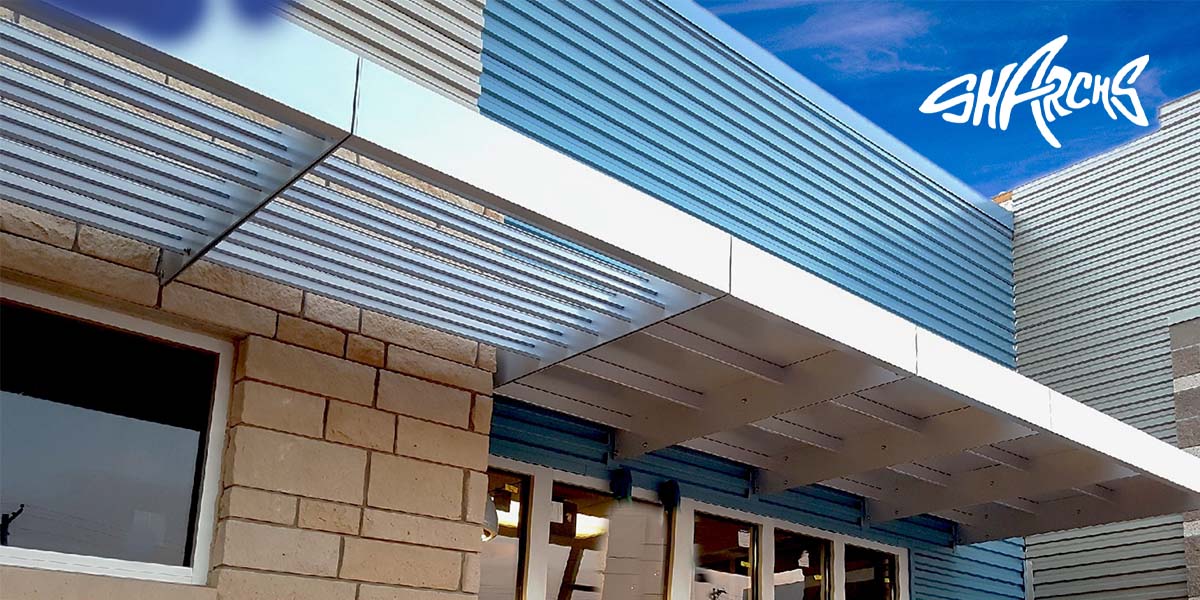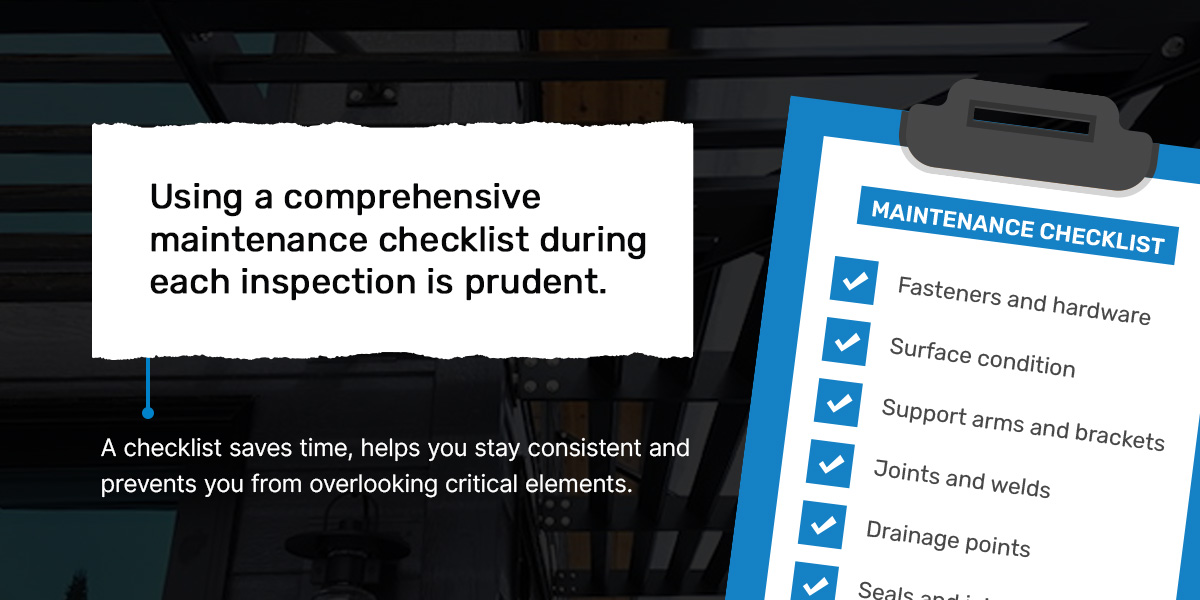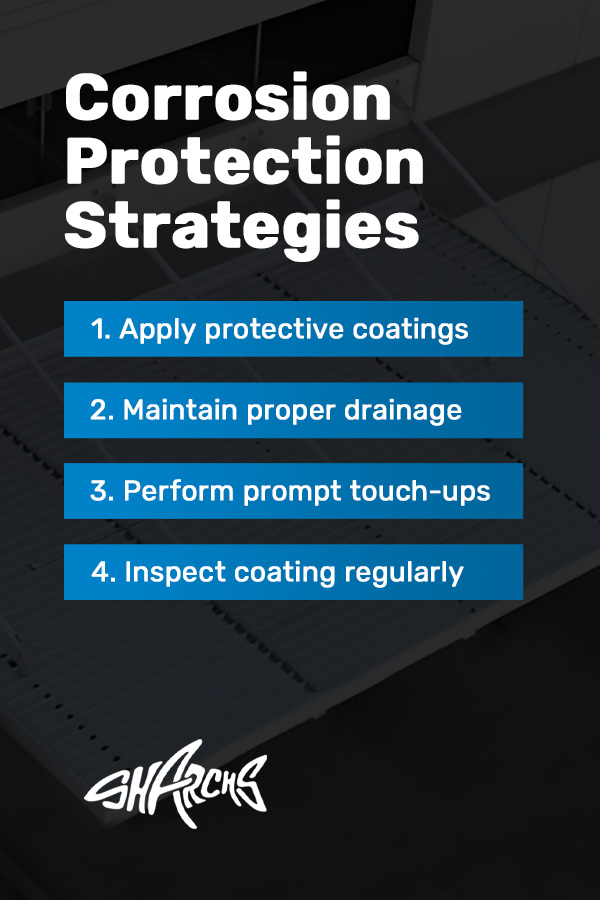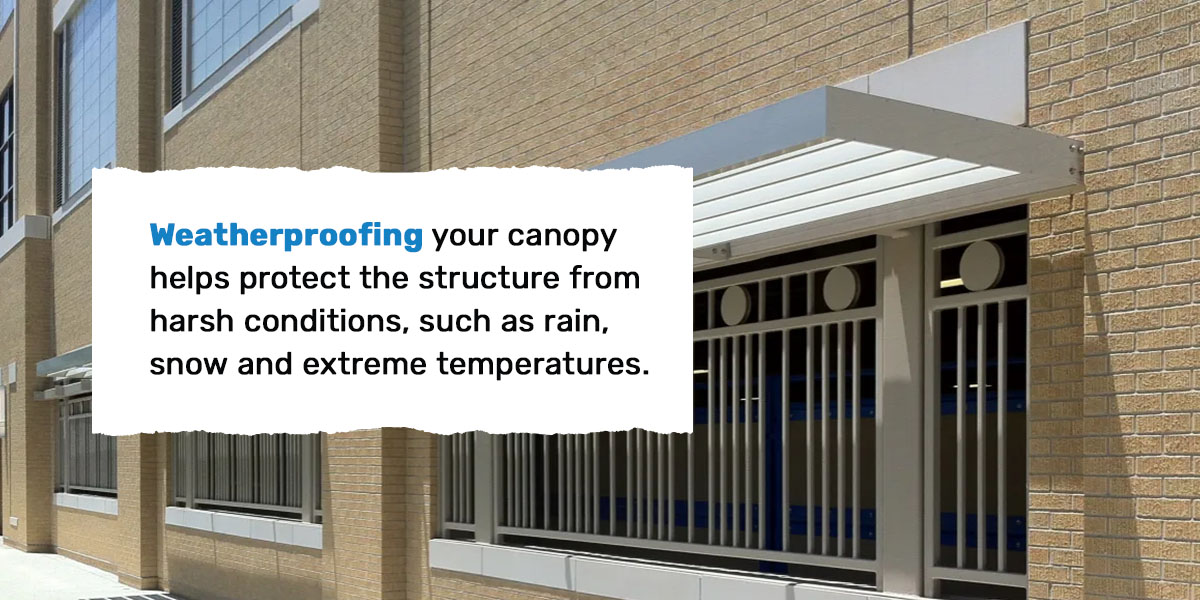
Aluminum canopies provide valuable protection and a professional appearance for any property. While durable, even the strongest canopies can deteriorate without regular maintenance, leading to increased wear, safety issues and less visual appeal. This guide explores effective maintenance practices to help you keep your metal awning canopy in top condition.
Understanding the Importance of Aluminum Canopy Maintenance
Proper maintenance minimizes issues like corrosion, damage and fading. It also ensures the canopy provides reliable shelter for entrances, walkways and outdoor spaces, supporting safety and comfort for occupants and visitors.
Routine upkeep of aluminum canopies offers numerous advantages, such as:
- Cost savings: Frequent maintenance identifies issues like loose fasteners or corrosion early, reducing the risk of expensive repairs or replacements.
- Prolonged lifespan: Keeping the canopy clean and in good condition helps maintain its structural integrity, significantly extending its useful life.
- Enhanced safety: Properly maintained canopies are less prone to sudden structural failures, ensuring the safety of visitors and employees.
- Improved aesthetics: A well-kept canopy provides a professional, clean appearance, enhancing your building’s overall curb appeal.
Metal awning canopies face numerous challenges that facility managers should monitor. A few examples include:
- Corrosion: Although aluminum resists rust better than other metals, it can still suffer from corrosion if exposed to harsh conditions without protection.
- Water pooling: Inadequate drainage leads to water accumulation, potentially causing structural damage and leaks.
- UV damage: Constant UV exposure gradually degrades paint and protective coatings, leading to fading and surface cracks.
- Fastener issues: Loose, missing or corroded bolts compromise canopy integrity and may pose safety hazards.
- Surface staining and dents: Over time, exposure to sun, pollutants, moisture and bird droppings can damage your canopy. You may notice water stains, dull finishes or minor dents. These blemishes and imperfections often require more than a quick rinse to remove.
How Often Should You Inspect and Maintain Your Canopy?
Ideally, you should inspect your commercial aluminum canopy thoroughly every three months. In harsher environments like coastal areas with high salinity and humidity, inspections should occur more frequently — around every one and a half months. Immediate inspections are also essential to check for damage or displacement after severe weather events such as storms, snowfall or high winds.

Using a comprehensive maintenance checklist during each inspection is prudent. A checklist saves time, helps you stay consistent and prevents you from overlooking critical elements. Here are some essential points to include in your canopy maintenance checklist:
- Fasteners and hardware: Check for rust, corrosion or loosening around bolts, screws and anchoring systems.
- Surface condition: Look for stains, discoloration, dents or other signs of wear that may require touch-up or cleaning.
- Support arms and brackets: Confirm that all structural elements are secure and aligned correctly. Identify any signs of bending or sagging.
- Joints and welds: Inspect for cracks, separation or signs of fatigue at connection points.
- Drainage points: Clear debris from drainage channels to prevent pooling.
- Seals and joints: Check seals and joints for any gaps that could lead to water infiltration.
- Accumulations: Check for debris or mildew and schedule cleaning accordingly.
- Add-ons and attachments: If your canopy includes lighting, signage or electrical components, check for stability and wear.
A checklist also helps you document inspections and reveal recurring issues over time, giving you better data to plan future metal awning canopy maintenance more effectively.
How to Clean an Aluminum Canopy
Cleaning your aluminum canopy regularly is one of the simplest ways to maintain its integrity and appearance. Here are some recommended cleaning tips and techniques:
- To remove stains or bird droppings, wipe the surfaces with a soft cloth or sponge dipped in warm water and a mild soap solution.
- Rinse thoroughly with clean water to remove soap residue and dry with a lint-free towel to prevent water spots and potential corrosion.
- Avoid abrasive brushes and harsh chemical cleaners such as bleach, ammonia or highly alkaline products, which may strip protective coatings or alter the metal’s finish.
- For sap, mold or embedded grime, soak the area first to soften before wiping gently. You can also use a cleaner formulated for stubborn spots on aluminum surfaces.
Safety Guidelines During Cleaning
Safety should always be a priority when cleaning your metal awning canopy. Here are some fundamental guidelines:
- Use proper equipment when cleaning at heights: If working at elevated or hard-to-reach surfaces, use fall protection or a secure platform such as a boom lift or a ladder. Never clean from the top of the canopy itself since these structures are not designed to support a lot of weight.
- Wear personal protective equipment: Use protective gear such as gloves and safety goggles to avoid injury from cleaning products or debris, and wear nonslip footwear to prevent falls.
- Keep the water pressure moderate: If using a hose or pressure washer, keep the pressure low or moderate — high-pressure sprays can damage the finish or loosen fasteners.
- Avoid abrasive materials: Avoid using materials such as steel wool and brushes with stiff bristles, as they can scratch the surface and cause long-term damage.
- Clean in good weather: Avoid cleaning during adverse weather like rain or high winds.
Protecting Aluminum Canopies Against Corrosion and UV Damage
Beyond regular cleaning, proactive steps to guard your outdoor canopy from corrosion and UV damage are essential.
When exposed to air or water, aluminum reacts with oxygen to form a thin aluminum oxide layer. This coating hardens on the surface and protects the metal from rusting. Even though aluminum does not rust, it does corrode, especially in environments with high or low pH levels. Extreme pH levels cause the protective aluminum oxide to break down faster than it can regenerate, leading to corrosion.

Some corrosion protection strategies include:
- Apply protective coatings: Applying a protective finish, such as powder coating or anodizing, creates a barrier that protects the aluminum from moisture and environmental damage.
- Maintain proper drainage: Ensuring water drains wholly and quickly prevents pooling that accelerates metal deterioration. Facility managers should routinely inspect and clear gutters and drain holes to maintain adequate runoff.
- Perform prompt touch-ups: Immediately treat minor scratches or chips in the finish with paint or a corrosion-resistant primer to prevent corrosion from spreading.
- Inspect coating regularly: Check the protective coating on your canopy often. Look for peeling, bubbling or discoloration, which may indicate the onset of corrosion.
Extended exposure to UV rays can cause aluminum to fade, discolor and weaken. This deterioration can significantly impact the aesthetic value of your outdoor canopy and reduce its lifespan. To protect your canopy from UV damage, consider:
- Using UV-resistant coatings: A UV-protective coating or powder coating adds an extra layer of protection against the harmful effects of the sun. This layer helps maintain the original color and shine of the aluminum.
- Installing a protective cover: If your canopy is not in use for an extended period, consider using a breathable cover to shield it from UV rays. Coverage is particularly useful in areas with intense sunlight.
- Inspecting your outdoor canopy regularly: Check for signs of discoloration or fading, especially after long periods of exposure to direct sunlight.
How Do You Stop Condensation on Aluminum Canopies?
Condensation can be a significant problem for aluminum canopies. Excess moisture can lead to corrosion, mold growth and water damage if not properly managed.
Condensation forms when humid air comes into contact with cooler surfaces, leading to water droplets that can accumulate on the undersides of canopies. Enhancing ventilation by installing vents or louvers can promote airflow and help reduce trapped moisture in enclosed spaces. Using moisture-absorbing materials like silica gel packs or desiccant dehumidifiers inside canopy compartments can also lower humidity levels and minimize the chances of condensation.
Proper drainage maintenance ensures your canopy remains free from water-related damage:
- Check the canopy’s slope: The canopy should have an appropriate slope for efficient water runoff. If the angle is too shallow, water may pool, increasing the risk of water damage.
- Address drainage blockages promptly: If you notice any signs of water pooling on the canopy, address them immediately. Clogged gutters or downspouts can lead to water retention, which can compromise the structure’s integrity over time.
- Inspect the drainage system routinely: Inspect drainage components quarterly and after severe weather events. Repair or replace any damaged or leaking sections promptly.
- Conduct seasonal cleaning: Perform routine drainage system cleaning and maintenance before and after seasonal weather changes.
Hardware and Structural Maintenance
Over time, expansion and contraction from temperature changes, vibrations and general wear can loosen bolts or compromise structural connections. Proper hardware and structural maintenance are crucial for the long-term stability of your aluminum canopy.
Inspecting and Servicing Fasteners, Bolts and Joints
Regularly inspecting fasteners, bolts and joints ensures the canopy remains safe and functional, providing reliable protection against the elements. Start with a close visual inspection. Look for corrosion, missing hardware or movement around connection points. Any bolt or bracket that wiggles under light pressure needs tightening or replacing.
Replace your fasteners with high-grade aluminum-compatible hardware in case of corrosion or damage. Lastly, look for signs of separation, fatigue or misalignment in the joints. If the canopy has welded elements, inspect the welds for hairline cracks or surface bubbling, which indicate potential failure points.
Weatherproofing and Sealing Edges

Weatherproofing your canopy helps protect the structure from harsh conditions, such as rain, snow and extreme temperatures. Apply a high-quality sealant to the edges and joints of the canopy to prevent water from infiltrating the structure. Sealing will reduce the risk of mold, mildew and corrosion.
Repair Best Practices and Replacement Indicators
Aluminum canopies require timely repairs to address wear and extend service life, but there comes a point when replacement is the smarter investment. Knowing when and how to act is essential for safety and budgeting purposes.
Common indicators that your canopy needs repair include visible dents, cracks or warping in metal components, loose or missing fasteners, and peeling or chipped coatings exposing bare metal. Water stains, mold or rust spots suggest compromised seals or drainage.
Deciding whether to repair or replace your aluminum canopy depends on the extent of the damage.
- Repair: You can often fix minor issues like loose fasteners, small dents or minimal corrosion without the need for full replacement. If the damage is localized and does not compromise the structural integrity, repairing the affected area is the most cost-effective solution.
- Replace: If the canopy has significant structural damage, such as extensive corrosion or considerable deformation, it may be time to replace it. Additionally, investing in a new canopy may provide better long-term value if the canopy is outdated or no longer serves its intended function.
Seasonal and Custom Fabrication Care
Your aluminum canopy will face different challenges and may require tailored care depending on factors such as regional climate, building orientation and design customizations. Adjusting maintenance frequency and techniques to align with the seasons ensures comprehensive protection year-round.
For instance, snow buildup can cause strain in regions with freezing winters. It is vital to remove snow promptly using soft tools and avoid deicing salts, which can corrode finishes. In hot, arid locations, reapply UV-resistant coatings regularly to preserve surface integrity. Falling leaves and clogged gutters pose specific threats in some locations in the fall. This time of the year is ideal for performing a full drainage review and clearing downspouts to prevent water buildup.
Custom canopies may include unique shapes, materials or finishes that require specific cleaning products or repair methods. Working closely with your canopy manufacturer or installer to understand these needs helps avoid damage and prolong the canopy’s lifespan.
Learn More From Sharchs Corporation
Consistency and the right strategies make metal awning canopy maintenance affordable and straightforward. At Sharchs Corporation, we have extensive experience with different types of canopies and can help you decide what type and style of awning will work best for your conditions.
We provide durable aluminum canopy systems with fast lead times and responsive support. We work closely with contractors and architects to meet real-world site demands and aesthetic goals. Contact our team today to learn more.

